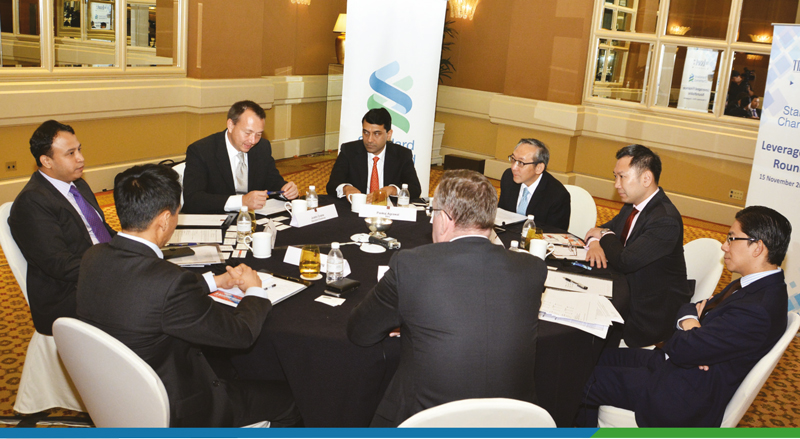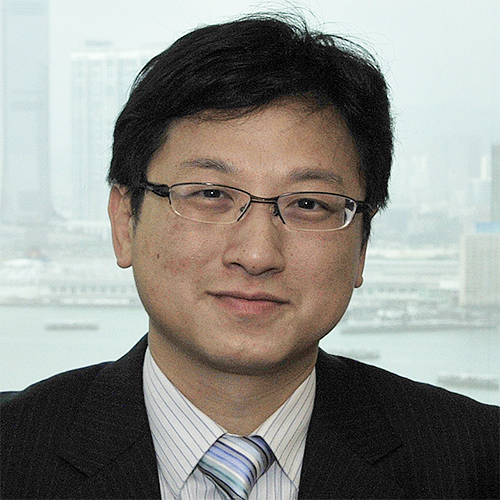Participants
Mike Samson, managing director & regional head leveraged finance, ASEAN, Standard Chartered Bank
Justin Crane, managing director & global head, loan syndicate & distribution, Standard Chartered Bank
Soo Jin Goh, principal & co-head Platinum Equity Asia
Pankaj Agrawal, executive director, syndicated finance, DBS
Joshua Chung, senior vice president, M&A and sponsor finance, SMBC
Philip Badge, partner, Linklaters
Gaurav Pant, principal, Apollo Management
Moderator
Daniel Yu, editor-in-chief, Asset Publishing and Research

There is an estimated US$100 billion of private equity (PE) funds that is pent up and looking for deployment. Sponsors have been modifying their strategies and getting very creative with deals just to get the capital moving. “It’s a borrower’s market now,” says Mike Samson, managing director and regional head of leveraged finance for Asean at Standard Chartered Bank.
Indeed, the leveraged finance market continues to offer opportunities and there is a lot of capital that still needs to be put to work, according to Pankaj Agrawal, executive director for syndicated finance at DBS. He says growth is still strongest in Asia, compared to other regions, and countries like India and Indonesia, despite falling behind expectations, are still likely to do better in the near future. China continues to exhibit a strong appetite for acquisitions and M&A activity.
Samson says that not all segments of the loan syndication market have suffered a decline, noting that leveraged buyouts, acquisitions and dividend recaps have recovered from 2015.
The loan activity in 2016 in Southeast Asia “has been flattered by one or two very large transactions,” he says, for example the US$6.2 billion acquisition of Thailand’s hypermarket operator Big C Supercenter by Berli Jucker in March.
“The acquisition market has shown a bit of a recovery from 2015,” adds Samson, “but it is only 10% to 11% of the total volume (of the loan market) so it cannot in any way move the needle.” And he warns: “This recovery may be quite short-lived. We’re looking at a very uncertain horizon for acquisitions. There will be a lot of smart money sitting on the sidelines waiting for volatility to die down.”
Justin Crane, managing director and global head for loan syndication and distribution at Standard Chartered Bank, notes that the volume of loan syndication market has declined by 7% in the first three quarters of 2016, compared the year before. The drop is also reflected in the deal count, with 820 deals during the same period, compared to around 900 in 2015.
Crane attributes the decline to lack of new money financing from the governments in the region, particularly India and Indonesia, which are not meeting the industry’s expectations. Some of the financing activity is likely to have shifted towards bilateral deals offered by banks reducing the number of loan syndications.
“Growth is slowing down, people are more risk-averse,” says Agrawal. Even through the M&A activity in the region is substantial, most of it originates from China. Chinese sponsors and companies, financed by Chinese or foreign banks stand out as the bright spot of activity in the slumping regional loan business. “If you take out China, M&A activity in Asia is down significantly,” he says.
Currency volatility, spurred by geopolitical events such as Brexit, has caused businesses to slow down their investment cycle, resulting in lower volumes, according to Agrawal. Furthermore, the decline in pricing has led to more refinancing activity rather than raising of new money.
“Overall volume may be on the decline, but as far as sponsor activity is concerned, I see a very healthy pipeline,” says Joshua Chung, senior vice-president for M&A and sponsor finance at Sumitomo Mitsui Banking Corporation. The trend started at the end of 2014 and has continued through 2015 and 2016.
Philip Badge, partner at Linklaters, notes that Chinese and Taiwanese banks have been more prominent in the loan business recently – many supporting deals by Chinese corporates. “We have seen Taiwanese banks supporting sponsors outside North Asia, which we did not see four or five years ago,” he says.
New entrants have been driving competition in the region and affecting terms of the deals. “The biggest impact is from Chinese banks,” adds Badge.
The consideration of the appropriate level of hold “does not seem to be the criteria as yet for Chinese banks,” he points out. They’ve been building up their books with enough capacity, diversifying from their base of local business to offshore, growing their balance sheet until their capacity is taken up. “They support balance sheet that some of banks won’t,” he adds.
Although competition from Chinese banks makes life difficult for others, as Crane admits, the flip-side is that they are a significant source of liquidity. And they are not the only banks looking abroad for assets. More competition comes from Japanese and Indian banks faced with low or negative rates.
The competition and the pressure to deploy capital is forcing the lenders to accept additional terms and add features to loan deals. While not yet common in Asia, European sponsors have been able to extract terms from high credit quality, large deals in the US market and implement them where it would otherwise seem inappropriate in Europe, says Badge. “All sorts of little minor tweaks to the documents, but if you add them all up, the incremental effect can be quite large,” he points out.
“Sponsors are looking not just for leverage, but also efficiency,” adds Chung. They’re coming up with new ideas on longer stretch tenor, bullet payments, etc, which are supported by emergence of quasi-institutional investors. Sponsors do not hesitate to reach to other markets in Europe or the US, if they get better terms.
Soo Jin Goh, principal and co-head of Platinum Equity Asia, says Asian PEs sometime feel penalized by Asian banks for negotiating a good transaction. “The Asian debt market is limited by 60% debt and 40% equity,” he says, “while in the US, you can get higher leverage and on more covenant light, higher average life structure.”
“We are hoping that with time it can gradually change,” Goh adds. “That our financial partners can go beyond the 60-40 guiding principle and take a more differentiated position based on the credit risk of the transaction.”
In the meantime, Goh says his company evaluates possible deals both for the Asia debt market and for the US debt market solutions, even though the latter is not always open to be tapped.
“What you’re missing in Asia is the capital layers,” says Samson. While it may appear to the sponsor that they are not getting enough leverage, in fact, on a senior basis, they actually are, he explains. “That level of leverage will already be moving into term loan B market, mezzanine market, bridge to high yield market and not staying at the senior (level).”
Another factor impairing the loan market in Asia is the lack of secondary market. “It’s a mentality where you’re married to the deals for the life of the transaction,” says Samson. This makes the banks more cautious as they usually have to live with their decisions for a long time.
While other regions offer the ability to de-risk using insurance of collateralized loan obligations (CLOs), these avenues are not yet well-developed in Asia. “Although the landscape is evolving, it is not as simple to get all of that protection as it is in Europe or the US,” says Samson. “The lack of capital layers, secondary loan market and fully developed de-risking modes keep a lid on what is possible in terms of the loan market in Asia.”
While the new mantra in the industry appears to be “originate to distribute”, ultimately the decision depends on how a bank benchmarks itself, says Crane. Although clearing out a loan book can lead to high return on the weighted average benchmark, the revenues come down to the dissatisfaction of equity holders. “There needs to be a balance,” he adds.
Getting secondary loan trading kick-started in Asia, in the par market, will be extremely difficult, says Crane, as 97% of end investors in loans are banks, which tend to hold them to maturity. Things may be a little different in the distressed loan market, which, albeit niche, has provided sold opportunities for a few players.
“It is a chicken-and-egg problem,” says Agrawal. In order for the volume to grow, there is a need for more institutional investors who play in this market, but they will participate only when enough volume is present. Banks in the region have enough liquidity and deposits, explains Agrawal, with healthy capital ratios which make it possible for them to hold assets to maturity.
The lack of common jurisdiction or harmonized standards among the countries in Asia constitutes a disadvantage when compared to large common jurisdictions like the US or Europe, according to Agrawal. (The multiple jurisdictions in Europe are connected by a common theme). In many countries in Asia, it is difficult to enforce a default or restructure a problem case in a timely manner, he says. Moreover, an institutional investor finds it hard to operate in 12 jurisdictions without an onshore presence, unlike banks that have multiple branches and a certain level of local understanding.
Agrawal notes that for a healthy secondary loan market to take off, more defaults, problem cases or restructurings need to reach a final resolution, helping investors establish their risk-reward profiles. The global financial crisis in 2008 caused a fair amount of distress in many of the Asia Pacific loan markets. However, as an example, in Australia more investors were comfortable buying loans at deep discounts relying on the better legal framework and enforcement regime, thus providing a boost to secondary trading volumes. “We need more such examples in Asia,” says Agrawal.
Crane notes that banks in 2016 have been reluctant to distribute. He says that the average hold in the market is around 18%. The reason for this reluctance is that banks are short on assets. “It’s a bit of an odd year,” he says. “A lot of our own are saying: ‘My book is light so don’t do too good a job on syndication’.”
Some banks have been looking beyond par loans, notes Gaurav Pant, principal at Apollo Management. “They are talking about loans, which are safe, the second loss piece and a synthetic trade,” he says. This implies that the banks will keep the loans on the books and will be talking to the borrower, thinking of solutions to take out some of the risk. “The borrower won’t feel that banks have abandoned them,” he adds.
The type and pricing of the deals being done highly depends on who is the acquirer, says Crane. The patina of the corporate level influences banks’ perception and lowers the pricing. The Big C Supercenter acquisition can serve as an example. The deal came out at 12.7x debt-to-Ebitda, but it still garnered quite a bit of support from banks, and the pricing was not commensurate with a transaction in excess of 10x, he says. Even though the company may have not been the strongest corporate within the umbrella of that group, the standing of the corporation made it palatable.
PE firms have it more difficult in some Asian jurisdictions, when competing with strategic investors, says Agrawal. In more developed markets of Hong Kong, Singapore, Japan or Australia, where there’s more discipline, better established jurisdictions, enforcement regime and more banks providing leveraged financing, PEs find it easier to compete on stretch terms.
“In certain jurisdictions, PEs will be successful,” says Agrawal, “because the bank financing will be available for both senior and mezzanine level, while in other jurisdictions it won’t.”
PEs also tend to be more aggressive in certain sectors, adds Agrawal, because there’s a theme, e.g. education sector is more stable or in other sectors where there are longer term contracts, steady cash flow and less capital expenditure. In those cases, strategic investors may also not be as keen, since the growth multiples could also be perhaps lower.

Strategic investors tend to be in a better position for deals that involve regulatory uncertainty, says Crane. If a cross-border deal faces protectionist hurdles, a strategic investor can “push it through the corridors of power” better than purely a holding company which is not in control of the deal collateral. A strategic would also be able to absorb the risk of non-approval better.
Looking towards future
Going forward, global markets have shown a lot of resilience, notes Crane. The biggest geopolitical events of the year, Brexit and the election of Donald Trump for the presidency of the US, have resulted in only short bouts of volatility. “Until base rates go up,” he says, “the liquidity will wash over everything.” The game will change, however, when the rates do go up.
Going forward, global markets have shown a lot of resilience, notes Crane. The biggest geopolitical events of the year, Brexit and the election of Donald Trump for the presidency of the US, have resulted in only short bouts of volatility. “Until base rates go up,” he says, “the liquidity will wash over everything.” The game will change, however, when the rates do go up.
“You cannot take the future for granted,” says Pant. With the expectations of the US interest rates going up and potential volatility in other parts of the world, business cash flows may look different. Capital needs to be deployed and companies need to be able to stand behind their investments even if conditions change and the results turn out different than expected.
“Fundamentals aren’t probably going to change much,” says Chung. Political reality, in particular the US foreign policy is another thing. “How US plays it role in Asia could have implications on corporate activity and cross-border transactions in the region,” he adds.
Improving the regulatory and legal infrastructure remains the priority for business in the region to grow, says Badge. Unfortunately, one often sees local banks “kick the can down the road” rather than approach the problems seriously.
Protectionist attitudes may express themselves in new ways and areas in 2017, notes Samson. “France and Italy will be the next test,” he says. China’s acquisition spree may be slowed down and thus significantly affect Asian loan volumes. Banks will likely remain risk-averse, waiting for geopolitical uncertainties to settle down.
“Our responsibility as PE practitioners is always to ask ‘what can go wrong?’,” says Goh. Understanding the amount of potential dislocation is the hard part. “We run more downside models than upside ones.” To deal with political or economic dislocations, practitioners in all markets need creativity and flexibility.





.jpg)
.jpg)


